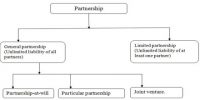Partnership Business: The inherent disadvantage of the sole proprietorship in financing and managing an expanding business paved the way for partnership as a viable option. Partnership serves as an answer to the needs of greater capital investment, varied skills and sharing of risks.
Features
Definitions given above point to the following major characteristics of the partnership form of business organization.
(i) Formation: It comes into existence through a legal agreement wherein the terms and conditions governing the relationship among the partners, sharing of profits and losses and the manner of conducting the business are specified.
(ii) Liability: The partners of a firm have unlimited liability. Personal assets may be used for repaying debts in case the business assets are insufficient.
Further, the partners are jointly and individually liable for payment of debts.
(iii) Risk bearing: The partners bear the risks involved in running a business as a team. The reward comes in the form of profits which are shared by the partners in an agreed ratio.
(iv) Decision making and control: The partners share amongst themselves the responsibility of decision making and control of day to day activities. Decisions are generally taken with mutual consent.
(v) Continuity: Partnership is characterized by lack of continuity of business since the death, retirement, insolvency or insanity of any partner can bring an end to the business.
(vi) Membership: The minimum number of members needed to start a partnership firm is two, while the maximum number, in case of banking industry is ten and in case of other businesses it is twenty.
(vii) Mutual agency: The definition of partnership highlights the fact that it is a business carried on by all or any one of the partners acting for all. In other words, every partner is both an agent and a principal. He is an agent of other partners as he represents them and thereby binds them through his acts.













